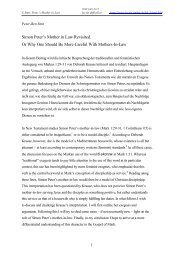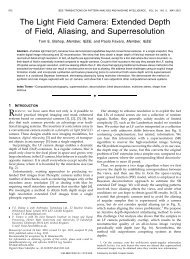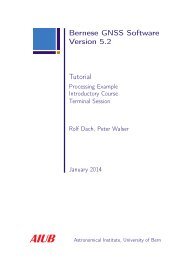Minimal Models of Adapted Neuronal Response to In Vivo–Like ...
Minimal Models of Adapted Neuronal Response to In Vivo–Like ...
Minimal Models of Adapted Neuronal Response to In Vivo–Like ...
You also want an ePaper? Increase the reach of your titles
YUMPU automatically turns print PDFs into web optimized ePapers that Google loves.
Adapting Rate <strong>Models</strong> 2103<br />
We show that under such conditions, Ermentrout’s model can be easily<br />
generalized, and the adapted response can be obtained as the fixed point <strong>of</strong><br />
f = (m − αf, s). For this result <strong>to</strong> hold, it is necessary that adaptation is<br />
slow compared <strong>to</strong> the timescale <strong>of</strong> the neural dynamics. <strong>In</strong> such a case, the<br />
feedback current αf is a slowly fluctuating variable and does not affect the<br />
value <strong>of</strong> s. Note that a slow adaptation is a minimal request in the absence<br />
<strong>of</strong> noise (Ermentrout, 1998).<br />
The proposed model is very general, but it can be used <strong>to</strong> full advantage<br />
only if the response function is known analytically. This is the case <strong>of</strong> simple<br />
model neurons, for which the rate function can be calculated, or more<br />
complex neurons whose f-I curve can be fitted by a suitable model function<br />
(e.g., Larkum, Senn, & Lüscher, in press). <strong>In</strong> section 2, the adapting rate<br />
model is introduced and tested on several versions <strong>of</strong> IF neurons, whose<br />
rate functions are known and easily computable. The resulting rate models<br />
are checked against the simulations <strong>of</strong> the full models from which they<br />
are derived, including the leaky IF (LIF) neuron with conductance-based<br />
synaptic inputs. Only slight variations are needed if a different mechanism<br />
<strong>of</strong> adaptation is considered, as, for example, an adapting threshold for spike<br />
emission, which is dealt with in section 2.2. Evidence is also provided that<br />
the LIF neuron with an adapting threshold is able <strong>to</strong> fit the response functions<br />
<strong>of</strong> rat pyramidal neurons (see section 2.3), a result that parallels those<br />
<strong>of</strong> Rauch et al. (2003) obtained with an afterhyperpolarization current. Finally,<br />
in section 3, we show how the stationary response function can be<br />
used <strong>to</strong> predict the time-varying activity <strong>of</strong> a large population <strong>of</strong> adapting<br />
neurons.<br />
2 Adapting Rate <strong>Models</strong> in the Presence <strong>of</strong> Noise<br />
Firing-rate adaptation is a complex phenomenon characterized by several<br />
timescales and affected by different ion currents. At least three phases <strong>of</strong><br />
adaptation have been documented in many in vitro preparations, referred <strong>to</strong><br />
as initial or one-interspike (ISI) interval adaptation, which affects the first or<br />
at most the first two ISIs (Schwindt, O’Brien, & Crill, 1997), early adaptation,<br />
involving the first few seconds, and late adaptation, shown in response <strong>to</strong> a<br />
prolonged stimulation (see Table 1 <strong>of</strong> Sawczuk, Powers, & Binder, 1997, for<br />
references and a list <strong>of</strong> possible mechanisms).<br />
<strong>In</strong>itial adaptation depends largely on Ca 2+ -dependent K + current (Sah,<br />
1996; Powers et al., 1999), although other mechanisms may also play a role<br />
(Sawczuk et al., 1997). The early and late phases <strong>of</strong> adaptation are not well<br />
unders<strong>to</strong>od, and several mechanisms have been put forward: in neocortical<br />
neurons, it seems that Na + -dependent K + currents (Schwindt, Spain, & Crill,<br />
1989; Sanchez-Vives, Nowak, & McCormick, 2000), and slow inactivation<br />
<strong>of</strong> Na + channels (Fleidervish, Friedman, & Gutnik, 1996) may play a major<br />
role; in mo<strong>to</strong>neurons, evidence is accumulating for an interplay between<br />
slow inactivation <strong>of</strong> Na + channels, which tend <strong>to</strong> decrease the firing rate,
















